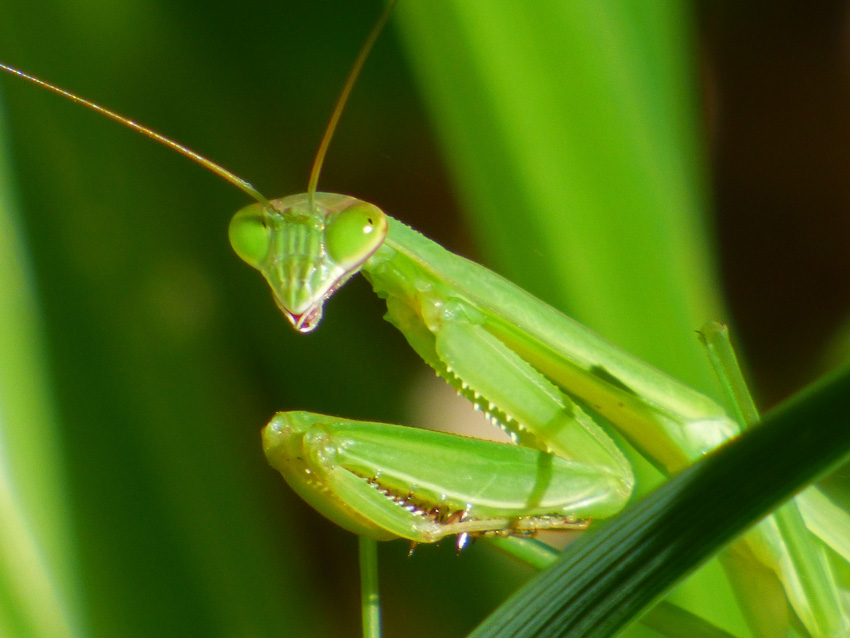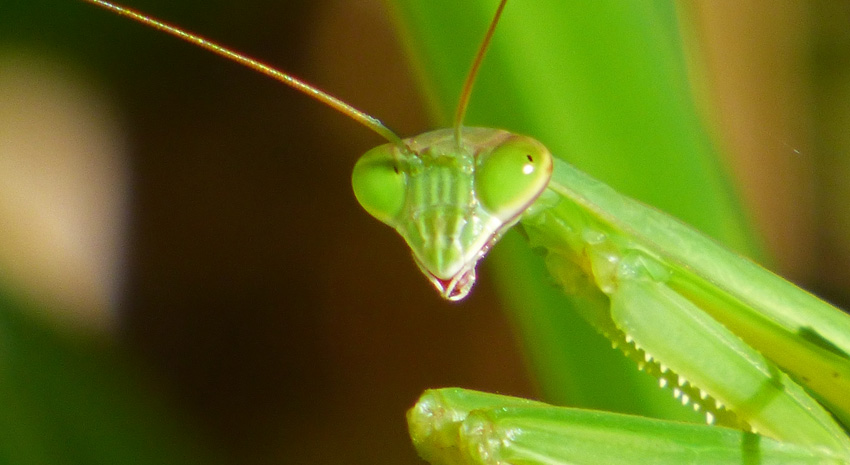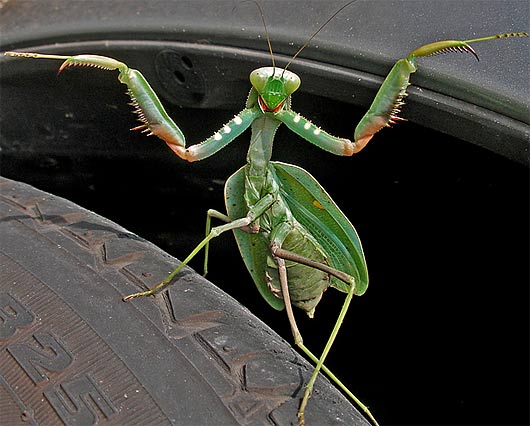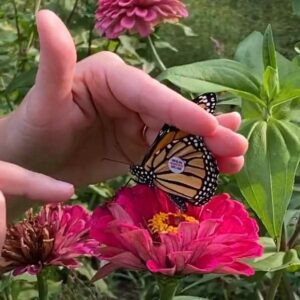 Praying mantids are distinctive insects, with elongated bodies, triangular heads, and spiny, prey-grabbing “raptorial” front legs (from the Greek word “raptor,” meaning “thief”). Mantids are usually a combination of gray, green, or brown, depending on the species. Like grasshoppers and crickets, mantids have thickened front wings which help protect their delicate hind wings. They also have chewing mouthparts. Praying mantids are also called mantises, mantids, and praying mantises. Since they are fierce predators, I don’t think it would be incorrect to call them “preying” mantis either. Only the brown Carolina mantis is native to Kentucky.
Praying mantids are distinctive insects, with elongated bodies, triangular heads, and spiny, prey-grabbing “raptorial” front legs (from the Greek word “raptor,” meaning “thief”). Mantids are usually a combination of gray, green, or brown, depending on the species. Like grasshoppers and crickets, mantids have thickened front wings which help protect their delicate hind wings. They also have chewing mouthparts. Praying mantids are also called mantises, mantids, and praying mantises. Since they are fierce predators, I don’t think it would be incorrect to call them “preying” mantis either. Only the brown Carolina mantis is native to Kentucky. Nymph and adult praying mantids are predators that feed on moths, butterflies, caterpillars, and other insects. Mantids are ambush predators. They are able to blend into foliage with their inconspicuous colors and wait for unsuspecting insects to fly within striking distance of their barbed front legs. They have even been photographed catching and eating hummingbirds! They do most of their hunting during the day, but are sometimes active at dusk. Praying mantids look tough, but they are not well defended from predators. Despite their protective coloration, praying mantids are often eaten by spiders, birds, and larger praying mantids. It is often said that praying mantid females eat males during the mating process. Although this sometimes occurs, it doesn’t always happen: the male is often able to escape.
Nymph and adult praying mantids are predators that feed on moths, butterflies, caterpillars, and other insects. Mantids are ambush predators. They are able to blend into foliage with their inconspicuous colors and wait for unsuspecting insects to fly within striking distance of their barbed front legs. They have even been photographed catching and eating hummingbirds! They do most of their hunting during the day, but are sometimes active at dusk. Praying mantids look tough, but they are not well defended from predators. Despite their protective coloration, praying mantids are often eaten by spiders, birds, and larger praying mantids. It is often said that praying mantid females eat males during the mating process. Although this sometimes occurs, it doesn’t always happen: the male is often able to escape.  The Chinese Mantid, is the largest praying mantid in Kentucky, reaching 4″ in length. Because of its large size, it is one of the most commonly seen mantids as well. Chinese mantids are usually either bright green, tan, or a combination. This mantid was introduced to the U.S. from China in the late 1800’s as a potential beneficial insect. It is no longer considered beneficial because it feeds on many desirable native insects, including butterflies and native praying mantids. They have large eyes for a reason: the many facets in their compound eyes allow them to see and capture prey as it flies past. Try to sneak up on a praying mantis, and you may be startled when it looks over its shoulder at you. No other insect can do so. Praying mantids have a flexible joint between the head and prothorax that enables them to swivel their heads a full 180 degrees. This ability, along with their rather humanoid faces and long, grasping forelegs, endears them to even the most entomophobic (insect fearing) people among us.
The Chinese Mantid, is the largest praying mantid in Kentucky, reaching 4″ in length. Because of its large size, it is one of the most commonly seen mantids as well. Chinese mantids are usually either bright green, tan, or a combination. This mantid was introduced to the U.S. from China in the late 1800’s as a potential beneficial insect. It is no longer considered beneficial because it feeds on many desirable native insects, including butterflies and native praying mantids. They have large eyes for a reason: the many facets in their compound eyes allow them to see and capture prey as it flies past. Try to sneak up on a praying mantis, and you may be startled when it looks over its shoulder at you. No other insect can do so. Praying mantids have a flexible joint between the head and prothorax that enables them to swivel their heads a full 180 degrees. This ability, along with their rather humanoid faces and long, grasping forelegs, endears them to even the most entomophobic (insect fearing) people among us.  Kung Fu Panda is one of my favorite movies. I can see where they got the idea to make Mantis one of the Furious Five, despite his small size. Ki-Yei! Looks pretty fearsome to me!
Kung Fu Panda is one of my favorite movies. I can see where they got the idea to make Mantis one of the Furious Five, despite his small size. Ki-Yei! Looks pretty fearsome to me!



